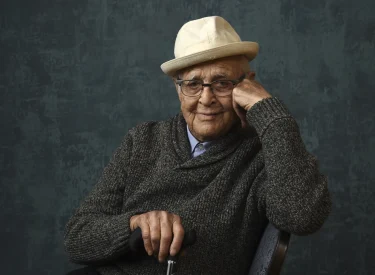An Appreciation: How Norman Lear Changed Television — and With it American life — in The 1970s
Associated Press-David Bauder - December 8, 2023 6:04 am

Norman Lear, on January, 13, 2020, in Pasadena, Calif. Lear, producer of TV’s “All in the Family” and influential liberal advocate, died at the age of 101 on December. 6, 2023.(AP photo/Chris Pizzello)
NEW YORK (AP) — In many American living rooms, the 1960s didn’t really begin until Jan. 12, 1971.
That was the night the comedy “All in the Family” debuted, almost instantly changing television and American society with it. Creator Norman Lear, who died at age 101 on Tuesday, was the man behind that transformation.
The series introduced the brash bigot Archie Bunker, his “dingbat” wife Edith, his feminist daughter Gloria and his liberal son-in-law Mike “Meathead” Stivic. From their house in the New York City borough of Queens, they co-existed loudly and watched the world spin uncontrollably.
Archie Bunker, portrayed by Carroll O’Connor, embodied the “American Way” — as most middle-aged white Americans understood it at the time — and watched in confused exasperation as “others” redefined it.
Coming out of a tumultuous decade of fundamental change, and smack in the middle of a contentious war overseas, these realities were hardly foreign to most Americans. They just rarely saw them reflected on television after dinnertime, after the nightly news was over.
If not in its infancy, television was barely out of its adolescence at the time. Most people had only one set in their homes — my family had upgraded from black-and-white to color less than two years earlier — and viewers watched the same handful of over-the-airwaves channels. Television programmers — watched closely by network censors and the Federal Communications Commission — rarely tread on topics that risked upsetting anyone.
“Before ‘All in the Family,’ television comedy was a vast playground for witches, Martians and crazy ladies who constantly dressed in disguises or mistook their husband’s boss for the milkman,” Aljean Hermetz wrote in The New York Times in 1972.
“Relationships were relentlessly stapled out of cardboard and then wrapped in cellophane with professional-looking bows,” Hermetz wrote. “The few non-plastic situation comedies were gentle and relatively melodramatic and contained no meanness.”
Menopause, miscarriage, marital spats — it was all fair game. Viewers learned to confront reality, and their differences, and find things to laugh about.
“I never thought of the shows as groundbreaking,” Lear told the Harvard Business Review in 2014, “because every American understood so easily what they were all about. The issues were around their dinner tables. The language was in their schoolyards. It was nothing new.”
The show was such a success, and so quickly, that in 1972 the liberal lead character in Lear’s sitcom “Maude” was deciding to undergo an abortion — the year before the Supreme Court legalized abortion with the Roe v. Wade decision.
It wasn’t without controversy. Lear asked TV Guide and other publications not to include “abortion” in their pre-show synopses. Two CBS stations in Illinois didn’t air it. The network didn’t want to air it, either, until Lear told them they’d have to find another show for their Tuesday night schedule.
That was the power that Lear had at the time. By the 1974-75 season, he was behind five of the 10 most-watched programs. And across the 1970s, whether it was race or gender or single parenthood, Lear used that power to create other sitcoms that reflected worlds that had rarely, if ever, been seen on television before.
There was the junkyard owner memorably portrayed by comic Redd Foxx in “Sanford and Son” (“This is the big one, Elizabeth,” he’d say, clutching his chest and pretending to have a heart attack). There was the struggling Black family in the Chicago projects in “Good Times” (with the “dy-no-mite” son portrayed by Jimmie Walker).
And most memorable of all, there was the striving Black family acclimating into a Manhattan “deluxe apartment in the sky” in “The Jeffersons,” a series introduced each week by the unforgettable theme song “Movin’ on Up.”
Actress Bonnie Franklin showed viewers the struggles and triumphs of a single mom raising two daughters in “One Day at a Time,” a series that made Valerie Bertinelli America’s sweetheart.
The candor and comedy he brought to the airwaves in the 1970s sealed his status, however, and any television show with realism at its core owes Norman Lear a debt.
In lasting until he was 101, Lear lived long enough to see his work appreciated by those who didn’t live through it the first time. “One Day at a Time,” for example, was remade from 2017 to 2020 with a Cuban family at its center. And Jimmy Kimmel lovingly helped produce televised run-throughs of some of Lear’s classic scripts acted by current stars.
Somehow, it worked. The exercise proved the durability of his scripts — and, instead of sounding dated, how so much of what they discussed is still relevant today.
___
David Bauder, the media writer for The Associated Press, has covered television for more than 25 years. Follow him at http://twitter.com/dbauder



